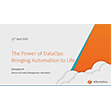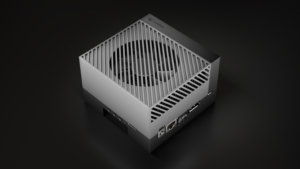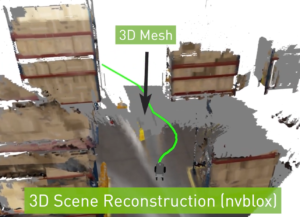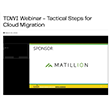

Nvidia Jetson Orin
Amid the flood of news coming out of Nvidia’s GPU Technology Conference (GTC) today were pair of announcements aimed at accelerating the development of AI on the edge and enabling autonomous mobile robots, or AMRs.
First, let’s cover Nvidia’s supercomputer for edge AI, dubbed Jetson. The company today launched Jetson AGX Orin, its most powerful GPU-powered device designed for AI inferencing at the edge and for powering AI in embedded devices.
Armed with an Ampere-class Nvidia GPU, up to 12 Arm Cortex CPU, and up to 32 GB of RAM, Jetson AGX Orin is capable of delivering 275 trillion operations per second (TOPS) on INT8 workloads, which is more than an 8x boost compared to the previous top-end device, the Jetson AGX Xavier, Nvidia said.
Jetson AGX Orin is pin and software compatible to the Xavier model, so the 6,000 or so customers that have rolled out products with the AI processor in them, including John Deere, Medtronic, and Cisco, can basically just plug the new device into the solutions they have been developing over the past three or four years, said Deepu Talla, Nvidia’s vice president of embedded and edge computing.
The developer kit for Jetson AGX Orin will be available this week at a starting price of $1,999, enabling users to get started with developing solutions for the new offering. Delivery of production-level Jetson AGX Orin devices will start in the fourth quarter, and the units will start at $399.
Recent developments at Nvidia will accelerate the creation of AI applications, Talla said.
“Until a year or two ago, very few companies could build these AI products, because creating an AI model has actually been very difficult,” he said. “We’ve heard it takes months if not a year-plus in some cases, and then it’s…a continuous iterative process. You’re not done ever with the AI model.”
However, Nvidia has been able to reduce that time considerably by doing three things, Talla said.
The first one is including pre-trained models for both computer vision and conversational AI. The second is the ability to generate synthetic data on its new Omniverse platform. Lastly, transfer learning gives Nvidia customers the ability to take those pre-trained models and customize them to a customer’s exact specifications by training with “both physical real data and synthetic data,” he said.
“We are seeing tremendous amount of adoption because just make it so easy to create AI bots,” Talla said.

Nvidia is developing simulation tools to help developers create AMRs that can navigage complex real-world environments (Image courtesy Nvidia)
Nvidia also announced the release of Isaac Nova Orin, is a reference platform for developing AMRs trained with the company’s AI tech.
The platform combines two of the new Jetson AGX Orin discussed above, giving it 550 TOPS of compute capacity, along with additional hardware, software, and simulation capabilities to enable developers to create AMRs that work in specific locations. Isaac Nova Orin also will be outfitted with a slew of sensors, including regular cameras, radar, lidar, and ultrasonic sensors to detect physical objects in the real world.
Nvidia will also ship new software and simulation capabilities to accelerate AMR deployments. A key element there is another offering called Isaac Sim on Omniverse, which will enable developers to leverage virtual 3D building blocks that simulate complex warehouse environments. The developer will then train and validate a virtual version of the AMR to navigate that environment.
The opportunity for AMRs is substantial across multiple industries, including warehousing, logistics, manufacturing, healthcare, retail, and hospitality. Nvidia says research from ABI Research forecasts the market for AMRs to grow from under $8 billion in 2021 to more than $46 billion by 2030.
“The old method of designing the AMR compute and sensor stack from the ground up is too costly in time and effort, says Nvidia Senior Product Marketing Manager Gerard Andrews in an Nvidia blog post today. “Tapping into an existing platform allows manufacturers to focus on building the right software stack for the right robot application.
Related Items:
Models Trained to Keep the Trains Running
Nvidia’s Enterprise AI Software Now GA
Nvidia Inference Engine Keeps BERT Latency Within a Millisecond
July 3, 2025
- FutureHouse Launches AI Platform to Accelerate Scientific Discovery
- KIOXIA AiSAQ Software Advances AI RAG with New Version of Vector Search Library
- NIH Highlights AI and Advanced Computing in New Data Science Strategic Plan
- UChicago Data Science Alum Transforms Baseball Passion into Career with Seattle Mariners
July 2, 2025
- Bright Data Launches AI Suite to Power Real-Time Web Access for Autonomous Agents
- Gartner Finds 45% of Organizations with High AI Maturity Sustain AI Projects for at Least 3 Years
- UF Highlights Role of Academic Data in Overcoming AI’s Looming Data Shortage
July 1, 2025
- Nexdata Presents Real-World Scalable AI Training Data Solutions at CVPR 2025
- IBM and DBmaestro Expand Partnership to Deliver Enterprise-Grade Database DevOps and Observability
- John Snow Labs Debuts Martlet.ai to Advance Compliance and Efficiency in HCC Coding
- HighByte Releases Industrial MCP Server for Agentic AI
- Qlik Releases Trust Score for AI in Qlik Talend Cloud
- Dresner Advisory Publishes 2025 Wisdom of Crowds Enterprise Performance Management Market Study
- Precisely Accelerates Location-Aware AI with Model Context Protocol
- MongoDB Announces Commitment to Achieve FedRAMP High and Impact Level 5 Authorizations
June 30, 2025
- Campfire Raises $35 Million Series A Led by Accel to Build the Next-Generation AI-Driven ERP
- Intel Xeon 6 Slashes Power Consumption for Nokia Core Network Customers
- Equal Opportunity Ventures Leads Investment in Manta AI to Redefine the Future of Data Science
- Tracer Protect for ChatGPT to Combat Rising Enterprise Brand Threats from AI Chatbots
June 27, 2025
- Inside the Chargeback System That Made Harvard’s Storage Sustainable
- What Are Reasoning Models and Why You Should Care
- Databricks Takes Top Spot in Gartner DSML Platform Report
- LinkedIn Introduces Northguard, Its Replacement for Kafka
- Change to Apache Iceberg Could Streamline Queries, Open Data
- Agentic AI Orchestration Layer Should be Independent, Dataiku CEO Says
- The Evolution of Time-Series Models: AI Leading a New Forecasting Era
- Fine-Tuning LLM Performance: How Knowledge Graphs Can Help Avoid Missteps
- Top-Down or Bottom-Up Data Model Design: Which is Best?
- Stream Processing at the Edge: Why Embracing Failure is the Winning Strategy
- More Features…
- Mathematica Helps Crack Zodiac Killer’s Code
- ‘The Relational Model Always Wins,’ RelationalAI CEO Says
- Confluent Says ‘Au Revoir’ to Zookeeper with Launch of Confluent Platform 8.0
- Solidigm Celebrates World’s Largest SSD with ‘122 Day’
- DuckLake Makes a Splash in the Lakehouse Stack – But Can It Break Through?
- The Top Five Data Labeling Firms According to Everest Group
- Toloka Expands Data Labeling Service
- Supabase’s $200M Raise Signals Big Ambitions
- With $17M in Funding, DataBahn Pushes AI Agents to Reinvent the Enterprise Data Pipeline
- Databricks Is Making a Long-Term Play to Fix AI’s Biggest Constraint
- More News In Brief…
- Astronomer Unveils New Capabilities in Astro to Streamline Enterprise Data Orchestration
- Databricks Unveils Databricks One: A New Way to Bring AI to Every Corner of the Business
- Seagate Unveils IronWolf Pro 24TB Hard Drive for SMBs and Enterprises
- Gartner Predicts 40% of Generative AI Solutions Will Be Multimodal By 2027
- BigBear.ai And Palantir Announce Strategic Partnership
- Databricks Donates Declarative Pipelines to Apache Spark Open Source Project
- Deloitte Survey Finds AI Use and Tech Investments Top Priorities for Private Companies in 2024
- Code.org, in Partnership with Amazon, Launches New AI Curriculum for Grades 8-12
- Databricks Announces Data Intelligence Platform for Communications
- Atlan Launches AI Data Quality Studio for Snowflake
- More This Just In…



























